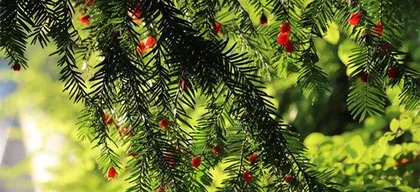The yew tree is a large tree widely distributed in southern China and Southeast Asia, with ornamental and economic value, and is widely used in landscaping and medicinal development. However, yew trees have high requirements for soil, making the selection of suitable planting soil a crucial issue for growers.

I. Understanding the Growing Environment of Yew Trees
Yew trees are native to the tropical Asian rainforests and prefer warm, humid environments. In their natural habitat, they are found at elevations ranging from 1000 to 2500 meters. This shows that yew trees have specific requirements for temperature, humidity, and light.
II. Soil Requirements for Yew Trees
Yew trees have very strict requirements for soil. Specifically, they require well-aerated, sufficiently moist, and organic-rich soil. Additionally, yew trees also have specific requirements for soil pH and fertility.

III. How to Measure Soil pH
Soil pH is one of the important factors affecting the growth of yew trees, so measuring it is particularly important. Generally, tools such as pH test kits or pH meters can be used for measurement.
IV. Selecting the Right Soil Texture
Different soil textures have different effects on the growth of yew trees, so selecting the right soil texture is a crucial step in planting. Generally, they prefer sandy or gravelly soil but are not well-adapted to clay soil.
V. Fertility and the Growth of Yew Trees
Fertility is one of the important factors affecting the growth of yew trees. When selecting planting soil, the issue of fertility should be considered. Applying the right amount of suitable fertilizer can effectively promote the growth of yew trees.

VI. Preparing Suitable Soil for Yew Trees
To meet the growth requirements of yew trees, we need to prepare suitable soil for them. Generally, we can use materials such as straw, lime, and sand to prepare the soil to meet the requirements for aeration, moisture, and nutrients.
VII. How to Improve Soil
When selecting planting soil, some shortcomings may be found. At this point, we need to improve the soil to meet the requirements of yew trees. Specifically, we can improve it by adding fertilizers, organic matter, etc.
VIII. How to Choose a Suitable Planting Site
To ensure the growth of yew trees, we need to choose a suitable planting site. Specifically, we need to consider factors such as the site's light conditions, drainage, temperature, and humidity.
IX. How to Transplant Yew Trees
After selecting a suitable planting site and preparing the soil, we need to transplant the yew trees. Specifically, we need to dig suitable planting holes, place an appropriate amount of fertilizer and soil in them, and then transplant the yew saplings.
X. Daily Maintenance of Yew Trees
After completing the transplantation of yew trees, we need to perform daily maintenance. Specifically, we need to pay attention to issues such as watering, fertilizing, and pruning to ensure the healthy growth of yew trees.
XI. Pest and Disease Control for Yew Trees
In the process of planting yew trees, various pest and disease problems may be encountered. At this time, we need to promptly take corresponding preventive and control measures to ensure the healthy growth of yew trees.
XII. How to Propagate Yew Trees
If you want yew trees to grow in a wider area, then you need to understand how to propagate them. Generally, we can use methods such as cuttings and grafting for propagation.
XIII. Economic Value of Yew Trees
Yew trees have high economic value and are widely used in medicine, furniture, and other fields. Understanding their economic value helps us to better choose planting methods and management practices.
XIV. Ornamental Value of Yew Trees
The yew tree is a beautiful plant with high ornamental value. Planting yew trees, in addition to being used as medicinal materials and furniture, can also add to the quality of life.
XV.
Yew trees have high requirements for soil, so attention must be paid when selecting planting soil. To meet their growth requirements, we need to understand their growing environment and soil requirements, and carry out corresponding soil improvement and formulation. At the same time, relevant issues need to be noted during daily maintenance and pest and disease control. Only by doing these well can we effectively promote the growth and development of yew trees.